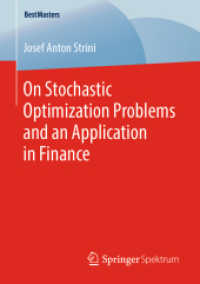Full Description
This book moves beyond a general introduction to Product Lifecycle Management (PLM) and its basic elements to provide a more in-depth analysis of the subjects introduced in Volume 1 (Product Lifecycle Management: 21st Century Paradigm for Product Realisation).
After providing insights into the emergence of PLM and the opportunities that it offers, key concepts such as the PLM Grid and the PLM Paradigm are introduced along with the 10 main components of PLM: objectives and metrics; management and organization; business processes; people; product data; PDM systems; other PLM applications; facilities and equipment; methods; and products. The book provides industry examples and best practices.
This new edition updates the previous edition of this book, reflecting the growth of PLM over the past decade of business and technological change. It concludes by showing readers how to implement and use PLM successfully. It outlines the phases of a PLM Initiative: development of PLM vision and strategy; documentation of the current situation; description of future scenarios; development of implementation strategies and plans taking account of the need for Organisational Change Management; implementation and use. The main activities, tasks, methods, timing, and tools of the different phases of implementation are described.
John Stark started working in product development in 1979. In the 1980s and 1990s, he worked in Computer-Aided Design/Computer-Aided Manufacturing (CAD/CAM), Engineering Data Management (EDM), Product Data Management (PDM), and Business Process Improvement. He has worked as a PLM consultant since 2001, and has experience with more than 100 companies in 20 countries across a range of manufacturing industry sectors. His PLM courses are taken throughout the world.
Contents
An Introduction to Product Lifecycle Management.- The Need for Product Lifecycle Management.- A Complex and Changing Product Environment.- Pain from Products, Pain with Products.- The Emergence of Product Lifecycle Management.- The Opportunities and Benefits of PLM.- The Product is at the Heart of PLM.- The Importance of Product Data in PLM.- The Importance of Business Processes in PLM.- Applications in the PLM Environment.- The PDM System in the PLM Environment.- People and PLM.- Methods and Techniques in the PLM Environment.- Facilities and Equipment of the PLM Environment.- Metrics in the PLM Environment.- Organisation and the PLM Environment.- Reasons for Implementing a PDM System in the PLM Environment.- Forewarned for PDM is Forearmed for PDM.- PDM Implementation and Use FAQs.- Impediments to Successful Implementation of PDM.- Of PLM Vision, Strategy and Planning.- Strategies and Principles.- Getting Executive Support for PLM.- PLM Vision Development and PLM Strategy Development.- PLM Vision: An Example.- The Current Situation of the PLM Environment.- Examples of the Current Situation.- Describing the Future Situation of the PLM Environment.- The PLM Implementation Strategy and Plan.- PLM Action and Activities.








